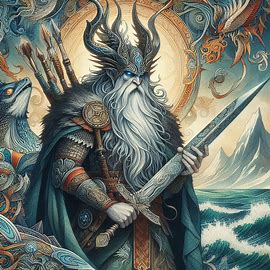
The Blade of Legends: Discovering the Secrets of the Viking Dagger
The Viking dagger, with its storied records and iconic layout, is a symbol of Norse craftsmanship, warrior prowess, and cultural identity. From the battlefields of ancient Scandinavia to the treasure troves of modern archaeology, the Viking dagger keeps to captivate our imagination and reveal insights into the lives of those mythical seafarers. In this article, we embark on a adventure to find the secrets and techniques of the Viking dagger, exploring its origins, significance, craftsmanship, and enduring legacy.
Origins of the Viking Dagger:
The Viking Age, which spanned from the overdue 8th to the mid-11th century, was a time of expansion, exploration, and conquest for the Norse people. The Viking dagger, also known as a sea or sax, become a common weapon and device utilized by Norse warriors and settlers at some stage in this era. Unlike the larger and extra ornate Viking swords, daggers were frequently greater utilitarian in layout, serving as flexible equipment for normal duties in addition to weapons for near combat.
Significance of the Viking Dagger:
The Viking dagger held both realistic and symbolic significance in Norse society. As a weapon, it become a vital device for self-defense, hunting, and struggle.
In Norse mythology and folklore, daggers have been frequently associated with gods such as Odin, the Allfather, who became said to wield a paranormal dagger named Gungnir.The dagger additionally performed a role in Viking burial rituals, wherein it become from time to time located along the deceased as a image of protection in the afterlife.
Craftsmanship of the Viking Dagger:
Viking daggers have been generally made from iron or steel, with blades ranging in length from a few inches to over a foot long.The blades of Viking daggers were frequently sample-welded, a way that worried forging together layers of various metals to create a blade with distinctive styles and better electricity. Handles had been generally crafted from materials consisting of wood, bone, antler, or horn, frequently embellished with intricate carvings or inlays of valuable metals.
Enduring Legacy of the Viking Dagger:
Despite the passage of centuries, the legacy of the Viking dagger keeps to undergo, both as a symbol of Norse heritage and as a source of inspiration for artists, historians, and fanatics.Viking daggers have been found in archaeological excavations across Scandinavia and past, offering treasured insights into Norse subculture, generation, and craftsmanship. Today, replicas of Viking daggers are prized by using creditors, reenactors, and fans who are seeking for to connect with the spirit of the Viking Age and honor the legacy of those mythical warriors.
Conclusion:
The Viking dagger stands as a testament to the ability, ingenuity, and resilience of the Norse humans. As both a weapon and a image, it played a relevant role within the lives of Viking warriors and maintains to fascinate and inspire us nowadays. By exploring the origins, significance, craftsmanship, and enduring legacy of the Viking dagger, we advantage a deeper information of the wealthy tapestry of Norse lifestyle and records. As we discover the secrets and techniques of this legendary blade, we pay homage to the indomitable spirit of the Vikings and their enduring legacy within the annals of history.






